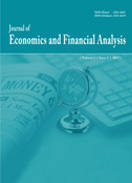URI: https://ojs.tripaledu.com/jefa/article/view/85/95
Forecasting Monthly Inflation in Bangladesh: A Seasonal Autoregressive Moving Average (SARIMA) Approach
DOI: http://dx.doi.org/10.1991/jefa.v7i2.a61
Abstract
Keywords
JEL Classification
Full Text:
References
Banerjee, A. (2021). Forecasting Price Levels in India: An ARIMA Framework. Academy of Marketing Studies Journal, 25(1), 1-5.
Box, G.E., & Jenkins, G.M. (1976). Time series analysis: Forecasting and Control. San Francisco. Calif: Holden-Day.
Enke, D., & Mehdiyev, N. (2014). A Hybrid Neuro-fuzzy Model to Forecast Inflation. Procedia Computer Science, 36, 254-260. doi:https://doi.org/10.1016/j.procs.2014.09.088
Farida, E., & As’ad, M. (2021). The Forecasting of Monthly Inflation in Malang City Using An Autoregressive Integrated Moving Average. International Journal of Economics, Business and Accounting Research, 5(2).
Faulina, R., Lusia, D., Otok, B., & Kuswanto, H. (2012). Ensemble method based on anfis-arima for rainfall prediction. 2012 International Conference on Statistics in Science, Business and Engineering, (pp. 1-4). Langkawi: IEEE.
Gautam, R.S., & Kanoujiya, J. (2022). Inflation Targeting: An Application of ARIMA Modelling Using Forecasting of CPI and WPI. Iconic Research and Engineering Journals, 5(11), 195-198.
Ghazo, A. (2021). Applying the ARIMA Model to the Process of Forecasting GDP and CPI in the Jordanian Economy. International Journal of Financial Research, 12(3), 70.
Hurtado, J., & Cortes-Fregoso, J. (2013). Forecasting Mexican inflation using neural networks. 23rd International Conference on Electronics, Communications and Computing (pp. 32-35). Mexico: IEEE.
Hurvich, C.M., & Tsai, C.L. (1989). Regression and time series model selection in small samples. Biometrika, 76(2), 297-307.
Işığıçok, E., Öz, R., & Tarkun, S. (2020). Forecasting and technical comparison of inflation in Turkey with box-jenkins (ARIMA) models and the artificial neural network. International Journal of Energy Optimization and Engineering, 9(4), 84--103.
Karadzic, V., & Pejovic, B. (2021). Inflation Forecasting in the Western Balkans and EU: A Comparison of Holt-Winters, ARIMA and NNAR Models. Academy of Economic Studies, 23(57), 517.
Kharimah, F., Usman, M., Widiarti, W., & Elfaki, F. (2015). Time series modeling and forecasting of the consumer price index Bandar Lampung. Science International, 27(5B), 4619-4624.
Kleiber, C., & Zeileis, A. (2008). Applied econometrics with R. New York: Springer Science & Business Media, LLC.
Lidiema, C. (2017). Modelling and forecasting inflation rate in Kenya using SARIMA and Holt-Winters triple exponential smoothing. American Journal of Theoretical and Applied Statistics, 6(3), 161-169.
Liko, R., Ramosaco, M., & Kashuri, A. (2016). Modeling the Behavior of Inflation Rate in Albania Using Time Series. Journal of Advance in Mathematics, 13(3), 7257-7263.
Marpaung, G.N., Soesilowati, E., Rahman, Y.A., Tegar, Y.D., & Yuliani, R. (2022). Forecasting the Inflation Rate in Central Java Using ARIMA Model. Indonesian Journal of Development Economics, 5(2), 163-173.
McNelis, P.D., & McAdam, P. (2004). Forecasting Inflation with Thick Models and Neural Networks. Frankfurt: European central Bank.
Mia, M.S., Nabeen, A.H., & Akter, M.M. (2019). Modelling and forecasting the consumer price index in Bangladesh through econometric models. American Scientific Research Journal for Engineering, Technology, and Sciences, 59(1), 118-127.
Ngailo, E., Luvanda, E., & Massawe, E.S. (2014). Time Series Modelling with Application to Tanzania Inflation Data. Journal of Data Analysis and Information Processing, 2(2), 49-59.
Nyoni, T. (2019). Munich Personal RePEc Archive (MPRA). Retrieved April 1, 2023, from https://mpra.ub.uni-muenchen.de/92429/
Okyere, F., & Mensah, C. (2014). Empirical Modelling and Model Selection for Forecasting Monthly Inflation of Ghana. Mathematical Theory and Modeling, 4(3), 99-106.
Olalude, G.A., Olayinka, H.A., & Constance, A.U. (2020). Modelling and forecasting inflation rate in Nigeria using ARIMA models. KASU Journal of Mathematical Science, 1(2), 127--143.
Otu, O.A., Osuji, G.A., Jude, O., Ifeyinwa, M.H., & Iheagwara, A.I. (2014). Application of Sarima models in modelling and forecasting Nigeria’s inflation rates. American Journal of Applied Mathematics and Statistics, 2(1), 16-28.
Qasim, T.B., Ali, H., Malik, N., & Liaquat, M. (2021). Forecasting Inflation Applying ARIMA Model with GARCH Innovation: The Case of Pakistan. Journal of Accounting and Finance in Emerging Economies, 7(2), 313--324.
Rahman, M.L., & Islam, M.M. (2020). Modeling Inflation in Bangladesh. Open Journal of Satistics, 10(6), 998.
Suleman, N., & Sarpong, S. (2012). Empirical Approach to Modelling and Forecasting Inflation in Ghana. Current Research Journal of Economic Theory, 4(3), 83-87.
Wati, D.A., Eltivia, N., & Djajanto, L. (2021). Inflation Forecasting by Commodity Using the Autoreggressive Integrated Moving Average (ARIMA) Method. In Proceedings of 2nd Annual Management, Business and Economic Conference (AMBEC 2020) (pp. 226-231). Atlantis Press.
Wolters, J., & Kirchgässner, G. (2007). Introduction to modern time series analysis (2nd ed., Vol. 271). Verlag Berlin Heidelberg: Springer.

This work is licensed under a Creative Commons Attribution-NonCommercial-NoDerivatives 4.0 International License.


